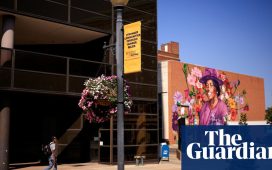The searing desert sun had brought the early afternoon temperature close to 100F (38C) but, inside, the rooms were an ambient 72, the beds neatly spaced and the walls decorated with crepe paper flowers and drawings of home or the Stars & Stripes.
This is the Trump administration’s newest detention center for children who have crossed the US-Mexico border and been apprehended by border patrol.
The health department-controlled facility has been open for less than two weeks, in the remote, tiny town of Carrizo Springs, Texas. It’s a far cry from the sordid scenes of overcrowding, dirt and hunger emerging recently from shocked legal experts and even the government’s own inspectors who had toured Customs and Border Protection (CBP) stations. Officials are keen to show off the new center, last week offering up to three media tours a day.
When the Guardian visited last Thursday, just under 200 teens aged 13 to 17 were held there, most from Honduras, Guatemala and El Salvador, who had either entered the US alone or been separated from the adults who accompanied them across the border, and they had all been transferred from other facilities.
The total number of children will grow to 1,300 over the coming weeks, all housed in what the government terms a “temporary emergency influx facility”. Carrizo Springs is one of two of these controversial entities – the other, in Homestead, Florida, had become the target of 2020 Democratic candidates’ ire in June – which are run by private companies or non-profits under federal contract. Advocates say they are not subject to the same rules and oversight as government-run centers, while activists say they are less shelter-like, more prison-like.

In contrast to images and reports from CBP stations, where children and adults are detained after first crossing the border, the Carrizo Springs facility is run by the not-for-profit Baptist Child and Family Services (BCFS) and is conspicuously clean and bright. It was recently refurbished from an old camp that accommodated men working in the local oil and gas production industries. Deep in rural Texas, it’s a 2.5-hour drive from San Antonio.
There were telephones for the children to call relatives or immigration lawyers. Also medical and mental health services and English lessons; there was easy access to showers, soap, toothpaste and toothbrushes, beds and real blankets.
This was all in sharp contrast to the border patrol stations that have failed to cater for an influx of families, including children and babies.
At a hearing on Capitol Hill last Friday, the Democratic representative Rashida Tlaib, in impassioned testimony, said: “We have a crisis on our border – it is one of morality.”
The sprawling Carrizo Springs compound has a high perimeter fence topped with barbed wire.
“People say this is a detention center because the kids aren’t ‘free to go’, but where would they go?” Kevin Dinnin, BCFS’s president and CEO, said.
He had said earlier that week: “I hate this mission … the only reason we do it is to keep the kids out of the border patrol jail cells,” the Washington Post reported.
And, apparently, away from non-government hazards, too.

“To ‘free the kids’ is child abuse because of human trafficking,” Dinnin told the Guardian, without elucidating further.
Mark Weber, a spokesman for the federal Office of Refugee Resettlement, an agency within the Department of Health and Human Services, said the Trump administration was committed to getting children out as quickly as possible.
“Our number one goal is to unify them with their sponsor and while that’s happening we’re providing them with a quality education,” he said.
Donald Trump has railed against releasing migrants. Amid strain on US systems, he and Vice-President Mike Pence blame the Democrats.
Systemwide, Weber said releasing teenagers from federal facilities was taking 93 days in November 2018. After removing a fingerprint requirement for sponsors’ households, which was discouraging US-based relatives, who may be undocumented, from coming forward to claim the children while they navigate the court process, the time dropped to 45 days.
Teens at Carrizo Springs enjoy religious services, regular meals, soccer and basketball, officials asserted.
Visiting media are banned from using recording devices or cameras, or interacting with the children. Those visible from some distance appeared clean and calm. Their true emotions, details of their pasts, treacherous journeys from troubled Central America and within the US and their uncertain future were impossible to discern.

Carrizo Springs is a quiet town of 5,800 residents, leery of newcomers. Some speaking anonymously said residents have an “out of sight, out of mind” perspective on the center, yet worried these “foreign children” would run amok and create havoc in town.
Claudia McDaniel, publisher of the Carrizo Springs Javelin newspaper, said: “Nobody wants kids to be held. I guess everybody’s like, ‘They need to go back home. They don’t have permission to be here if they’re illegal.’ It’s a big border patrol community.” She added the town was supportive of enforcing laws but also “If our government is holding these kids, that they’re doing so in a humane way.”
Meanwhile, Mayra Mendoza, a San Antonio immigrant women’s rights activist who participated in a recent demonstration against the detention center, believes the people of Carrizo Springs need to “open their eyes” to the “injustices” in their own backyard.
“They are picking places with the biggest land and smallest population. I think that’s by design to encounter the least resistance,” she said.

Charanya Krishnaswami, advocacy director for the Americas at Amnesty International USA, opposes the Carrizo Springs center. With the facility being run by a non-government agency, it is not subject to the same state-licensing requirements as other facilities, she said.
“We believe state licensing is a critical form of oversight,” Krishnaswami said. “It allows state authorities to conduct inspections,” she added, as well as obliging shelters to provide comprehensive education, and follow other guidelines on how the children are looked after.
Hope Frye, an attorney and volunteer advocate for migrants, echoed Krishnaswami’s concerns – and said if the government was prepared to change how it helps reunite children with their sponsors in the US, influx shelters wouldn’t even be required.
“You don’t need them. You don’t have them. You set up a program designed to release kids. If you release kids expeditiously, you never need an influx shelter – and you need far fewer regular shelters.”

With such expeditious processing, “you’d never have kids stuck anywhere”, Frye said.
Back in Carrizo Springs, Juan Mancias, chairman of the Carrizo/Comecrudo Native American tribe of Texas, said locals are more focused on job opportunities than questions of ethics or morality around the treatment of migrants, although he saw a complicated picture.
“There’s an economic void in the area because [of lack] of jobs, so it’s a form of gentrification by corporations coming in and creating false hopes. These jobs aren’t going to last for ever and a lot of people aren’t aware of what happens in rural areas – they really don’t care, if they got a job in the city,” he said.
Most of the jobs at the new detention center have gone to out-of-towners, but a few have gone to locals.
“A lot of people will do what they can to survive in these small towns,” he said.








